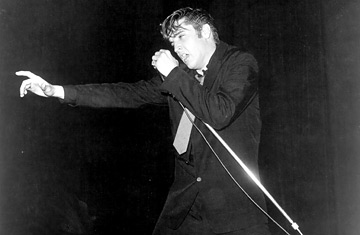
Elvis Presley circa 1957
Devotees of Elvis Presley marking this summer's 30th anniversary of his death at a key Paris exhibit will know they're not in Memphis anymore. The French capital is offering up a decidedly more cerebral look at the rock 'n' roll phenomenon, attaching it to a socio-political critique unlikely to be found at Graceland. The show, Rock 'n' Roll 39-59, at the Cartier Foundation for Contemporary Art, views Elvis's hip-shaking and Jackson Pollock's drip-painting as reflections of the same impulse: "Two young people living in a society that they want to provoke, to rebel against, and to mock sometimes," as Foundation president Alain Dominique Perrin puts it. "This was the America that had liberated the world of Nazism," says Perrin, "but this was also a racist America, a puritan America, a hyper-conservative, McCarthyite America."
Elvis as an "Un-American" in Paris? Obviously, this is no Lite FM stroll down memory lane. Rock 'n' Roll 39-59 traces its subject back to the Dec. 23, 1938, Carnegie Hall concert titled From Spirituals to Swing, which ignited a nationwide boogie-woogie explosion and marked the breakout moment for African-American music. Boogie-woogie dug the well from which rock 'n' roll would later draw its attitude and rhythm.
For rock critic and historian Greil Marcus, who lectured on Buddy Holly at the exhibit opening earlier this summer, the orderly, complacent society of postwar America was a tinderbox ready to explode. "In the 1950s, the official story was that America was back to normal: women were out of the factories, everything was working like clockwork," he said. "But underneath this was an entirely different story of confusion, conflict, desperation, desire for grandeur. Life could be an epic story, life was dangerous, you could step outside the role that had been preordained for you."
To capture that edgy sense, the exhibition collates music, film, some 700 photographs, a replica of a '50s recording studio, Elvis's guitar and even an iconic 1953 Cadillac. No one epitomized rebellion like Elvis did, of course, and the exhibition includes a large collection of little-known photos by Alfred Wertheimer, who shadowed the rising star in 1956.
The rock 'n' roll explosion came amid the dawning of a new world. Photojournalist Ernest Whithers found himself at once covering early performances of Elvis and B.B. King, and documenting the civil rights struggle. The juxtaposition of those parallel developments can be revealing. On the exhibition's timeline of the era is a photo of a handsome African-American boy in a hat. "You look over your shoulder at another picture of a nine-year-old Fats Domino, and they look the same," says Marcus. "You think, who's that rock 'n' roll singer with the hat? But it's Emmett Till, a 14-year-old boy from Chicago who was lynched in Mississippi in 1955."
The fertile mixing of the era's tragedies and triumphs is what sets Rock 'n' Roll 39-59 apart from exhibits that focus on showbiz alone. Says Marcus, rock 'n' roll is a synonym for "taking risks" and "pushing too far," yet if it takes a dose of French savoir-faire to make an exhibit that treats it as high art, so much the better. "I don't think there is any separation between rock 'n' roll artists and supposedly more legitimate artists," he says. "The songs that Elvis or Chuck Berry sang were all arguments about the nature of American society and modern life — what it was, what it could be, what it should be."
In the decade's final years, rock 'n' roll's golden era faded quickly: Elvis was drafted, Chuck Berry was arrested, Little Richard found God, DJ Alan Freed was kicked off the air, Jerry Lee Lewis married his 13-year-old cousin, and Buddy Holly, Ritchie Valens and J.P. "The Big Bopper" Richardson died in a plane crash. And then, after 1959 rock 'n' roll went global, leading John Lennon to decree that "Before Elvis, there was nothing." Well, not exactly, as the Paris exhibition chronicles. But after him, there was infinitely more.
